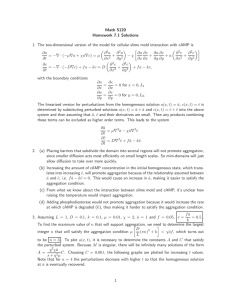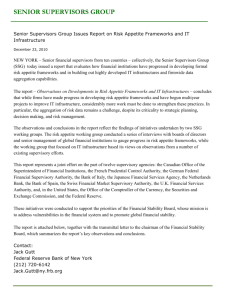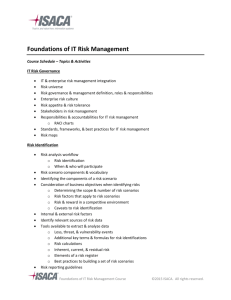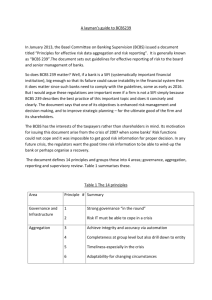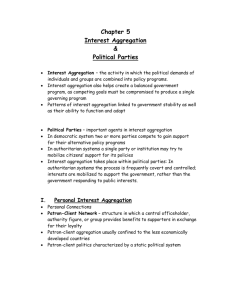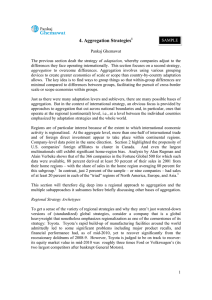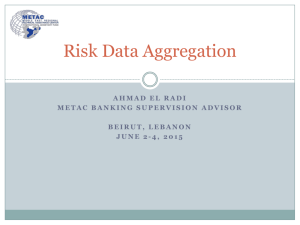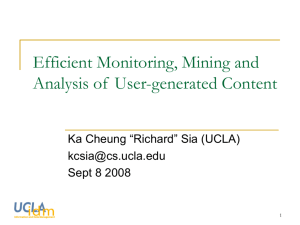Council Summary of RDA Principles
advertisement
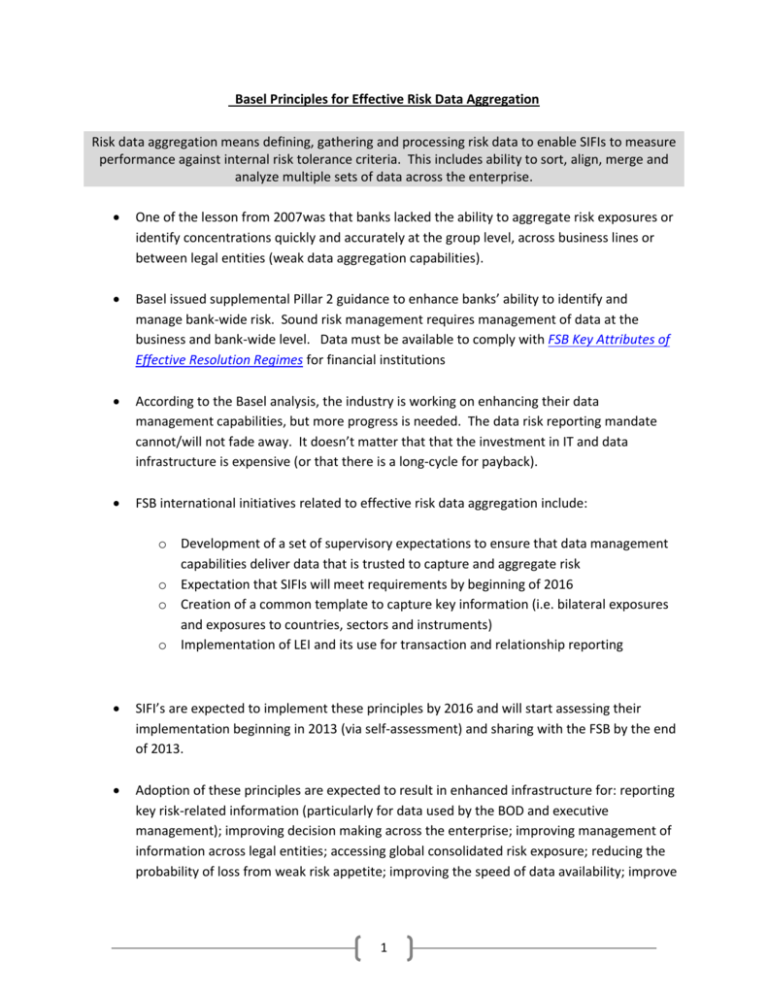
Basel Principles for Effective Risk Data Aggregation Risk data aggregation means defining, gathering and processing risk data to enable SIFIs to measure performance against internal risk tolerance criteria. This includes ability to sort, align, merge and analyze multiple sets of data across the enterprise. One of the lesson from 2007was that banks lacked the ability to aggregate risk exposures or identify concentrations quickly and accurately at the group level, across business lines or between legal entities (weak data aggregation capabilities). Basel issued supplemental Pillar 2 guidance to enhance banks’ ability to identify and manage bank-wide risk. Sound risk management requires management of data at the business and bank-wide level. Data must be available to comply with FSB Key Attributes of Effective Resolution Regimes for financial institutions According to the Basel analysis, the industry is working on enhancing their data management capabilities, but more progress is needed. The data risk reporting mandate cannot/will not fade away. It doesn’t matter that that the investment in IT and data infrastructure is expensive (or that there is a long-cycle for payback). FSB international initiatives related to effective risk data aggregation include: o Development of a set of supervisory expectations to ensure that data management capabilities deliver data that is trusted to capture and aggregate risk o Expectation that SIFIs will meet requirements by beginning of 2016 o Creation of a common template to capture key information (i.e. bilateral exposures and exposures to countries, sectors and instruments) o Implementation of LEI and its use for transaction and relationship reporting SIFI’s are expected to implement these principles by 2016 and will start assessing their implementation beginning in 2013 (via self-assessment) and sharing with the FSB by the end of 2013. Adoption of these principles are expected to result in enhanced infrastructure for: reporting key risk-related information (particularly for data used by the BOD and executive management); improving decision making across the enterprise; improving management of information across legal entities; accessing global consolidated risk exposure; reducing the probability of loss from weak risk appetite; improving the speed of data availability; improve 1 quality of strategic planning; and improving the ability to manage risk from new products. Long term value of improving risk management capabilities, outweigh the initial investment cost of enhancement. SIFI’s have no choice – this must be implemented. And while this report is directed to SIFI’s but national supervisors may apply the principles to other participants in the financial ecosystem as they think appropriate. This report aligns with the “risk appetite framework” as defined by the Senior Banking Supervisors Report (Observations on Developments in Risk Appetite Frameworks and IT Infrastructure). The objectives of both reports work in alignment with each other. This report is about risk management principles – but should also be applied to financial and operational processes within the financial institution. These principles also apply to any process that is outsourced to a 3rd party and are organized into four categories (governance, risk data aggregation, risk reporting and supervisory review). These processes are described separately but they are interconnected and need to be managed as part of an overall risk appetite framework. The Basel Committee will track progress toward compliance with these principles through its Standards Implementation Group (SIG) from 2013. SIG is chaired by Charles Taylor, Deputy Comptroller for Regulatory Policy at the Office of the Comptroller of the Currency (OCC). Principle One: Strong governance over risk data aggregation capabilities is required. This includes the definition of service level standards for all risk data-related processes. The Board and senior management are accountable for risk data oversight. Risk data practices need to be fully documented and subject to independent validation to review the appropriateness/effectiveness and quality of the governance. Independent validation refers to an entity with specific data and reporting knowledge (working in conjunction with the internal audit function) Data oversight extends to new initiatives, acquisitions or divestitures, new product development and large scale change activities (integration and data alignment) Risk data limitations need to be articulated to the BOD with a plan for remediation 2 Principle Two: IT infrastructure and architecture need to support risk data aggregation capabilities in both normal and during stress times Risk data aggregation is to be considered as part of the BCP of the bank The bank should establish integrated data taxonomies and architecture across the enterprise (including information on the characteristics of metadata, the use of standard identifiers, and standard naming conventions for data. This does not mean a single data model – rather a mechanism for alignment, concordance and reconciliation. Roles and responsibilities for data (stewards, owners) need to be implemented to ensure data quality, implement control processes, align data with standard definitions and ensure that data can be aggregated Principle Three: Risk reports should be accurate in times of stress and (largely) automated to minimize errors Controls for risk data should be a rigorous as those for accounting data A single authoritative source of risk data is ideal The bank should maintain a standard “dictionary” of risk concepts and implement the standard definitions across the enterprise The risk data management process needs to be precisely defined and documented (banks must demonstrate provenance over their risk data management processes) Data accuracy must be measurable with traceability to root cause Principle Four: Risk data must be complete and captured/aggregated across the enterprise Risk data aggregation must be complete (including those instruments, business activities and transactions that are off balance sheet) The measurement of risk (methodologies, calculation processes) need to be transparent and complete Principle Five: Risk data must be timely (although timing can vary according to risk profile) Timing is not prescriptive but will depend on the type of data and the type of risk Specific call outs include: aggregated credit exposure to a large corporate borrower (via watchlists), counterparty credit risk exposures (i.e. derivatives), trading exposure, positions, operating limits, market concentrations, liquidity risk indicators (i.e. cash flow/settlement and funding) and operational risk indicators 3 Principle Six: Risk data systems should be able to meet on-demand, ad hoc risk management reporting requests (particularly during crisis situations) Get ready for ad hoc, on-demand reporting (and specific scenario based analysis) Tools and dashboards for risk data analytics are required Flexibility based on new business development, external factors, bank profiles and changes in the regulatory framework is required Principle Seven: Risk data must be accurate and the firm must be able to reconcile/validate reports Executive management must be able to rely on the output of the risk data reporting system (trust and confidence in the data must be assured) Accuracy includes defined requirements/processes, reasonableness checks, validation rules, conventions for risk calculations, exception management, precision tolerance ranges The litmus test for risk data is analogous to that for accounting materiality Principle Eight: Risk data must be comprehensive and cover all material risk areas across the enterprise All significant risk areas (i.e. credit, market, liquidity, operational) and risk objectives (i.e. single name, country and sector exposure) need to be included in the risk reporting process Risk concentration needs to be evaluated in terms of the risk appetite/tolerance of the firm Completeness is based on the firms business models and risk profiles but the criteria for determining completeness needs to be transparent Proactive and forward-looking risk analysis is required Principle Nine: Risk management reports need to be clear, concise and comprehensive Risk data needs to be meaningful and actionable. Risk aggregation needs to be transparent and traceable Risk reporting requirements are not standardized but need to be precisely defined by the individual financial institution. Risk reporting gaps needs to be tracked and reconciled Senior management is accountable for risk reporting 4 Principle Ten: The frequency of risk reporting is determined by the financial institution and adjusted based on circumstance Risk reporting frequency varies based on type of risk and recipient Quick reporting in times of crisis are required Principle Eleven: Risk reports are to be distributed to all relevant stakeholders Procedures to facilitate rapid collection, analysis and distribution are needed Regulatory audits of risk data collection processes are likely Principle Twelve: Banking Supervisors will periodically audit banks on the risk data principles Compliance with the principles of risk data aggregation will be monitored The supervisory audit process is not standard. Principle Thirteen: Supervisors have authority to ensure remediation of risk data management deficiencies Compliance with risk data aggregation is mandatory Supervisors have lots of tools to ensure compliance (i.e. supervision intensity, 3 rd party audit, capital add-ons, limits on activity, pre-authorization requirements) Principle Fourteen: Cross regulatory regimes cooperation will take place Risk oversight is a global objective and many of the players are universal banks. Cooperation among regulators is necessary 5

